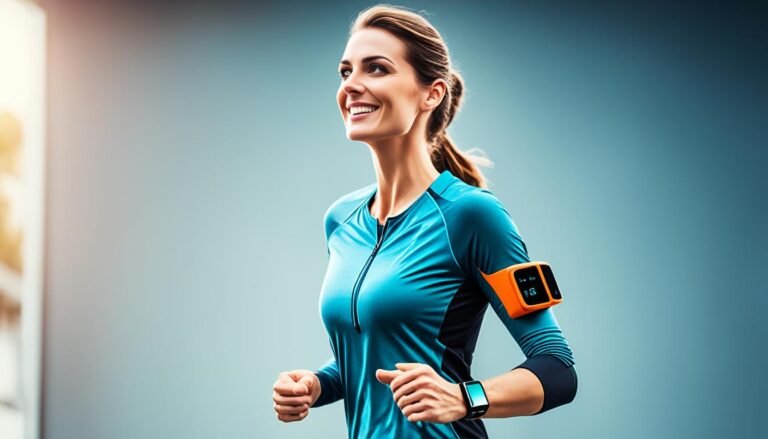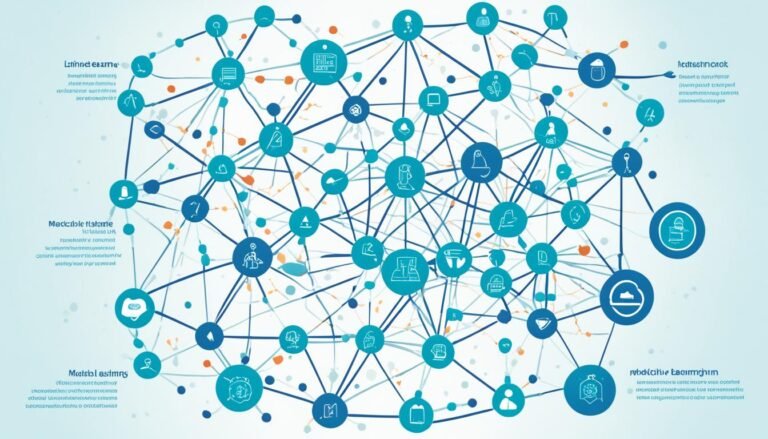Wearable Health Tech: Guide to Trackers & IoMT
Imagine a world where your watch does more than tell time. It could save your life. That world is here with the rise of Wearable Health Tech. Watches used to just keep time. Now, health trackers track our heartbeats and exercise, becoming a key part of our health routine. The market for these gadgets was over $112 billion in 2021. It’s growing fast, thanks to new IoMT technology and fitness wearables. These smart health devices are at the forefront of wearable tech trends. They could change healthcare forever.
Health monitoring has come a long way from counting steps. Now, health monitoring devices are our partners in staying well. They’re more than just gadgets. They’re leading us to a lifestyle of connected living. This includes IoMT solutions and connected health gadgets. They help us take a proactive approach to our health.
Key Takeaways
- The Wearable Health Tech market is experiencing remarkable growth, harnessing the power of IoMT to transform healthcare.
- Health Tracker Devices aren’t just fitness tools; they’re becoming critical in proactive health management and disease prevention.
- From consumer-level Fitness Wearables to advanced Smart Health Devices, there’s a wide variety of options to suit individual needs.
- IoMT Solutions are carving a path for improved patient care, reduced healthcare expenses, and optimized treatments through ongoing monitoring.
- Connected Health Gadgets demonstrate the increasing desire for interconnectivity and real-time data in personal and clinical settings.
- The expanding realm of Wearable Tech Trends forebodes a future where healthcare is more tailored, accessible, and, importantly, patient-centric.
Understanding Wearable Health Tech and Its Impact on Healthcare
Wearable Health Tech is now more than just fitness tracking. It includes a range of Smart Health Devices that give real-time health data. There are many kinds of Health Monitoring Devices. These range from simple step counters to complex tools that provide key details about one’s health. Let’s look into some top Connected Health Gadgets in the market:
| Device Type | Health Metrics Monitored | Typical Usage |
|---|---|---|
| Smartwatches | Heart rate, Steps, Sleep quality | Everyday activity tracking, Notification management, Wellness monitoring |
| Fitness Bands | Exercise duration, Calories burned, Distance traveled | Workout sessions, Goal-setting, Progress tracking |
| Clinical-Grade Monitors | Blood pressure, ECG, Blood oxygen saturation | Patient remote monitoring, Clinical data collection, Advanced health tracking |
| Wearable ECG Monitors | Heart rhythm, Atrial fibrillation detection | Cardiac patient care, Early detection of cardiac events |
| Biosensor Patches | Temperature, Heartbeat, Respiration rate | Post-surgery recovery, Chronic illness management, Continuous care |
Wearable Health Tech is valuable for its convenience and healthcare benefits. By promoting preventive care, these Smart Health Devices help reduce pressure on traditional healthcare services. This also lowers costs in the long run. With these Health Monitoring Devices becoming part of our daily lives, they greatly affect patient care. Patients are more involved and informed about their health management thanks to these advanced Connected Health Gadgets.
Adopting these tech advances, healthcare is moving towards a more active and preventive approach. With these smart, connected tools, healthcare is changing from reactive to predictive and personalized. This is truly changing how we view and manage our health and wellness.
The Evolution of Health Tracker Devices
The story of health tracker devices is like a journey through technology, starting simple and growing complex. We explore a world where Wearable Health Tech meets Smart Health Devices. Together, they create a rich world of Fitness Wearables. These gadgets help with fitness and give detailed health insights.
A Brief History and Breakthroughs in Wearable Devices
A long time ago, the pedometer was born. It was simple but important for what was to come. Then, sensors got better, smaller, and more powerful. Thanks to these advancements, modern wearables can do so much more. They track not just steps but also breathing, calories, and other health stats.
From Pedometers to Smart Watches: The Journey of Health Trackers
Pedometers were just the beginning. Now, we have Fitness Wearables that do a lot more. Companies like Apple and Samsung have made smartwatches that are really advanced. These gadgets don’t just count steps. They can check your heart, blood oxygen, and even do ECGs. They are the peak of Wearable Health Tech.
Here’s a look at how Fitness Wearables have changed over time. We see the features they have added and improved:
| Feature | Pedometer Era | Early Smart Devices | Modern Health Trackers |
|---|---|---|---|
| Step Tracking | Yes | Yes | Yes |
| GPS | No | Yes | Yes |
| Heart Rate Monitoring | No | Yes | Advanced with HRV |
| Caloric Burn | No | Estimate | Precise Algorithms |
| Sleep Tracking | No | Basic | Detailed with REM Phases |
| Stress Tracking | No | No | Yes |
| ECG Functionality | No | No | Yes |
| Smart Notifications | No | Yes | Yes |
| AI Integration | No | No | Yes |
The world of Health Tracker Devices is always getting better. Now, they also look at mental health. And, we can’t wait to see what’s next in biometrics. Smart Health Devices are moving us to a new level of health knowledge and control.
“Wearable Health Tech: Your Guide to Trackers, IoMT, and Beyond”
The world of IoMT solutions and Wearable Health Tech is changing our health habits. These gadgets, like fitness wearables and smart health devices, act as personal health guides. They help us take care of our health early, even before we get sick.
IoMT tools are great for different needs, like keeping tabs on daily routines, managing long-term health issues, or helping with recovery. Fitness wearables keep track of our steps, heart rate, and calories, turning these numbers into helpful advice. For those with chronic conditions, advanced devices offer control and peace of mind by watching over health stats.
Smart health devices affect more than just individual care; they create a connected world of healthcare. They let doctors tailor treatments better and act fast due to real-time data sharing. IoMT connects everything, improving how we monitor health from afar and talk to our doctors. This makes life better for many people.
Now, the line between gadgets for us and tools for doctors is getting fuzzy. Some wearables are so good they’re used in hospitals for constant patient check-ups. This mix of everyday tech and medical standards is leading to a future where we all watch over our health with the help of our gadgets.
The promise of IoMT and Wearable Health Tech is unlimited. It’s moving us to a time where we don’t just check our health; we improve it. Every piece of data helps us live better and longer. Looking ahead, we see a world where taking care of our health is a continuous journey, guided by these innovative technologies.
Distinguishing Between Consumer and Clinical-Grade Trackers
In the world of wearable health tech, it’s key to know the difference between everyday wearables and clinical ones. Consumer-grade trackers, like smartbands, focus on fitness. But clinical ones need Regulatory Approval and are often checked by the FDA for Wearables. They differ in design, use, and rules they follow.
Intent of Usage for Various Health Tracking Devices
Brands like Apple and Fitbit make consumer-grade trackers for fitness fans. They help users track their activities and goals. Clinical devices, however, monitor vitals and are key in diagnostics and care.
Regulatory and Approval Processes: FDA Oversight for Wearables
Consumer and clinical devices also differ in how they are regulated. Devices that claim medical benefits must get FDA Approval. They must be accurate and safe. The table below shows how wearables are classified, including those under FDA watch versus those focused on wellness.
| Type of Device | Examples | Intended Use | Regulatory Category |
|---|---|---|---|
| Consumer-Grade Trackers | Fitbit Charge, Apple Watch (basic models) | Fitness tracking, General wellness | Not FDA regulated |
| Clinical-Grade Devices | Apple Watch (ECG models), Samsung Galaxy Watch3 (ECG feature) | Medical diagnostics, Patient monitoring | FDA Class II |
| High-Risk Medical Devices | Implantable pacemakers, Infusion pumps | Life-sustaining treatments, Critical monitoring | FDA Class III |
Understanding the difference between tracker types helps consumers make smart choices. It sheds light on the FDA’s role in Wearables amid the growing tech. As the market expands, the roles of both tracker types will get clearer. They aim at improving wellness and aiding healthcare providers.
The Advent of IoMT Technology in Modern Healthcare
IoMT technology is rapidly shaping modern patient care. It combines old medical methods with new digital innovations. This change greatly improves how we monitor and manage health.
The Role of Connected Devices in Patient Monitoring and Diagnostics
Connected devices play a big role in patient care. They include things like wearable blood pressure monitors. These devices make checking health stats easy and accurate.
They allow for better monitoring of health conditions. This means doctors can keep track of health details more accurately. It leads to better patient care.
Now, healthcare providers can check on patients without meeting in person. This remote monitoring boosts patient comfort and follows treatment plans better. Doctors get patient data faster, making care for chronic diseases better.
How IoMT Is Altering Healthcare Delivery and Management
IoMT is changing how we deliver healthcare. It connects devices to offer better, focused care. Sharing health data quickly can improve healthcare quality.
Hospitals see better workflows and patient care with IoMT. It helps treat patients remotely, cutting costs. It also aims at preventing and managing long-term diseases better.
IoMT is a game-changer in healthcare. It’s set to make care better, personalize treatment, and create integrated health systems.
Exploring the Diversity of Fitness Wearables
The world of Fitness Wearables keeps growing, attracting lots of attention. Today, you can find a health tracker for almost any fitness goal. These devices reflect the latest in Wearable Tech Trends. They suit different needs and dreams of people all over.

For those who love counting steps, there are gadgets just for that. Others, who think good sleep is key, can find devices that track sleep in detail. There’s now a push for Health Tracker Devices that do more. They check how we exercise and keep an eye on important health stuff like stress and how much water we drink.
Today’s Wearable Health Tech goes beyond just collecting info. These devices help guide your exercise routine. They give tips, suggest workouts, and tell you when to rest. They’re like having a coach, nutritionist, and health expert with you all the time.
As we all start caring more about our health and use more tech, fitness wearables are at the heart of it. They motivate us to live healthier, smarter lives.
Looking into different fitness wearables shows there’s something for everyone. Whether you’re an athlete, a fitness lover, or just want to be more active, there’s a device out there for you. This variety helps everyone find what works best for them. It also inspires new, innovative gadgets for the future.
Health Monitoring Devices: Shaping Patient-Centric Care
As we explore health monitoring devices, we see they are more than gadgets. They are key to creating care that focuses on the patient. Through continuous health data collection and connected health gadgets, healthcare becomes personalized and engaging for patients.
Benefits of Continuous Health Data Collection
Today, wearing health tech is crucial for patient care. It gives a detailed view of a patient’s health outside of doctor visits. It helps manage chronic diseases and catches issues early. Health trackers let caregivers tailor care to each person’s needs.
These devices also let health experts see patient progress as it happens. I o M T solutions offer smart ways to make medical decisions and adjust treatments when needed.
Case Studies: Wearables Transforming Chronic Disease Management
Wearable tech has changed how we manage chronic diseases. For instance, CGMs have transformed diabetes care, giving patients control over their condition. The Philips Biosensor and Temp Traq patch are also revolutionary. They track vitals without being invasive, critical during disease outbreaks. These devices prove that connected care is vital for improving patient health.
Trends in Wearable Tech and Predictions for the Future
The future of wearable tech is on the edge of a big change. Emerging technologies in health wearables plan to offer devices that do more than just track health. They will use IoMT technology to create health plans, analyze mood patterns, and manage chronic diseases with amazing accuracy.
Emerging Wearable Tech Trends and Their Implications
We are witnessing fast growth in connected health devices. These devices are moving from just reacting to predicting healthcare needs. They use advanced sensors and analytics to give insights before any symptoms show. This shift towards a proactive approach could improve our health knowledge and well-being greatly.
Picture your smartwatch giving advice on when to sleep based on your day. It may also predict health issues before they happen. Wearable tech is getting closer with IoMT, making these devices key to our health.
Where Is Wearable Health Tech Heading?
The wearable health tech space is becoming more connected. Imagine different devices sharing data to offer a complete health overview. Soon, we might see smart implants and diagnostic patches. These could send health updates and give medicines without needing a hospital visit.
Soon, wearables could also map our genetic data for custom health plans. This move towards personalized care is creating a new age of connected health devices. Everyone could have their own health ecosystem with IoMT tech.
Health monitoring gadgets are going to be more than what we have now. They will offer a health experience that is personalized and proactive. We are eager to see how wearable tech will change our health and wellness in the future.
Conclusion
In the fast-paced world of today, Wearable Health Tech and IoMT Solutions stand out by changing how we handle our health. They mix convenience with clinical use, changing wellness and disease management. We now have tech that tracks our activities and watches our health, alerting us to important changes.
Fitness Wearables and similar tech have started a new chapter in patient care. They make health monitoring easy, allow for instant data sharing, and let patients manage their health from home. This shift gives people control over their conditions and helps doctors get the info they need quickly.
The rise of Connected Health Gadgets is clear in their sales and the positive effects on our health. As this sector grows, these innovations continue to shape our future. With Wearable Health Tech and IoMT Solutions, we’re moving towards more personal healthcare, leading to a future where we know and meet our health needs with amazing accuracy.
FAQ
What is wearable health technology?
How has wearable health tech evolved over time?
What are the differences between consumer-grade and clinical-grade health trackers?
What role does the FDA play in the regulation of wearable health tech?
How is IoMT technology impacting modern healthcare?
What types of fitness wearables are available on the market?
What are the benefits of continuous health data collection from health monitoring devices?
Can you give examples of wearables in chronic disease management?
What emerging trends are shaping the future of wearable health tech?
What is the future for wearable health technology?
Source Links
- https://www.ncbi.nlm.nih.gov/pmc/articles/PMC9940964/
- https://www.linkedin.com/pulse/essential-guide-exploring-internet-medical-things-iomt-mohamed-kahna
- https://ventionteams.com/blog/wearable-health-technologies

Our Healthcare Editorial Team is composed of subject matter experts and seasoned healthcare consultants who bring decades of combined experience and a wealth of academic qualifications. With advanced degrees and certifications in various medical and healthcare management fields, they are dedicated to supporting the personal and career development of healthcare professionals. Their expertise spans clinical practice, healthcare policy, patient advocacy, and public health, allowing us to offer insightful, well-researched content that enhances professional growth and informs practice.
Disclaimer
The client education section of our blog is intended to support healthcare providers by offering informational resources for patient education. However, this information is not meant to serve as medical advice. We advise healthcare professionals to ensure all content is consistent with their clinical knowledge and confirm with current medical standards before using it in their practice or advising patients. For specific medical issues, always refer to professional guidance and standards of care.
For any legal matters or specific medical concerns, we strongly recommend consulting with a qualified legal professional or referring to government websites for authoritative information.




